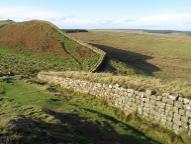News & Events
Call for Papers
Constructed in the 2nd century AD as a monumental frontier complex of the Roman Empire, Hadrian’s Wall has enjoyed a long and complex existence.
The initial fuction of the Wall can be characterised as a border monument, creating a physical barrier of Roman army bases across the Tyne-Solway isthmus of what is now northern England. Occupied by the Roman army from circa AD 120 until the early 5th century, the Wall still continued to capture interest and imagination from at least the 6th century AD. The Byzantine historian Procopius’ offers the following description of Hadrian’s Wall (History of the Wars 8.20.42-8):
Now in this island of Britain the men of ancient times built a long wall, cutting off a large part of it; and the climate and the soil and everything else is not alike on the two sides of it. For to the east of the wall there is a salubrious air, changing with the seasons, being moderately warm in summer and cool in winter. But on the west side everything is the reverse of this, so that it is actually impossible for a man to survive there even a half-hour, but countless snakes and serpents and every other kind of wild creature occupy this area as their own. And, strangest of all, the inhabitants say that if a man crosses the wall and goes to the other side, he dies straightway. They say, then, that the souls of men who die are always conveyed to this place.
We invite papers that explore the cultural significance and impact of Hadrian's Wall. Topics may include, but are not limited to:
- The Wall in Literature (incl. Historical, Science, Romance, Historical Romance & Spy Fictions)
- Landscape
- Women and the Wall
- The Wall in Cyberspace
- The Power of Names/Myths
- Transmission
- Myth-Making and a Sense of Place
- Visual and Plastic Arts
- The Wall and Hollywood
- Classical Reception and Neo-Mediaevalisms
- Children, Children’s Literature and the Wall
- Materialities
- Curated Histories
- Capturing the Past
- Soundscapes
- Maps and Mapping the Wall
- Object Biographies
- The Wall and Other Walls
We welcome papers that explore these topics from English and Other Literatures, Film and Television Studies, Archaeology, History, Heritage Studies, Cartography, Fine Art, Music, Folklore, Museology, Digital Humanities, Geography, Politics and Sociology.
Submissions can be sent to the conference email.
The deadline for submission is 29 February 2016.
Last modified: Sun, 07 Feb 2016 22:49:38 GMT
